ArtScience celebrates 25th anniversary

GRAFFITIZER 2 is an algorithmic graffiti installation, which creates graffiti pieces based on the drawing style of its creator; Daniel Berio. Resulting from years of experience as a graffiti artist, Daniel created this system during his ArtScience research as an attempt to merge the aesthetics of his own style of graffiti letters with algorithmic art. He developed generative graffiti algorithms whose output is fed to physical drawing machines and augmented with real-time projections, mixing real ink with projected light as a painterly medium.
Daniel Berio
Daniel Berio (1978) is a software developer, artist and designer from Florence, Italy. Since a young age Daniel got actively involved in the international graffiti art scene and his work became known in Italy, Europe and the USA. In the meantime he developed a professional career first as a graphic designer and later as a programmer in video games, multimedia and audio-visual software. In 2010 Daniel moved to the Netherlands where he worked as a graphics programmer for VJ software Resolume. In 2013 he obtained a Masters degree from ArtScience Interfaculty in The Hague, where he researched methods of simulating his graffiti-drawing style algorithmically and developed drawing machines and installations materializing the output of the generative-graffiti process. Today Daniel lives in the UK where he is continuing his research at the Department of Computing in Goldsmiths College, London.
http://www.enist.org/
Sebastian Frisch BIOPHONIC GARDEN
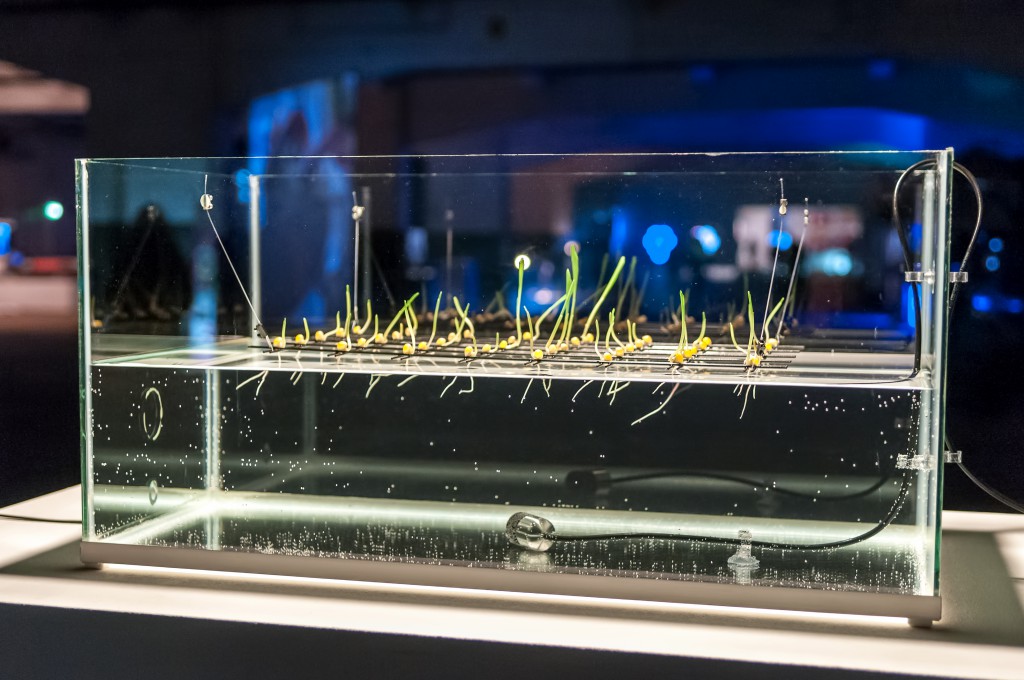
Biophonic Garden uses an experimental laboratory setup to display the possibility of making a dialogue between young corn plants perceivable for human ears. Sprouted corn seeds are arranged on a grid which is situated in a container filled with water. The acoustic environment beneath the seeds is picked up by underwater microphones, which allows visitors to listen to the dialogue between the young corn plants. While the roots of the plants are submerged in the water, a constant sine tone of 220 hertz is played into the water which has an influence on the growing process of the roots, they bend towards the sound source. The phenomena of plants reacting to acoustic stimuli originated from scientific research into plant bioacoustics and is used in the work to raise questions about the communication of plants and the acoustic environment we humans live in.
Sebastian Frisch
Sebastian Frisch researches and creates works as an artist, musician, and developer. He makes use of a diverse set of media technologies to create immersive experiences and discover possible connections between the digital and the palpable. His main interest belong to the fields of sound, space and acoustic ecology. Sebastian studied Sound Art and Computer Science at Salzburg University of Applied Sciences and graduated recently from the ArtScience Master’s program at the Royal Conservatory and the Royal Academy of Art, The Hague.
http://www.freshmania.de/
Ivan Henriques Jurema Action Plant
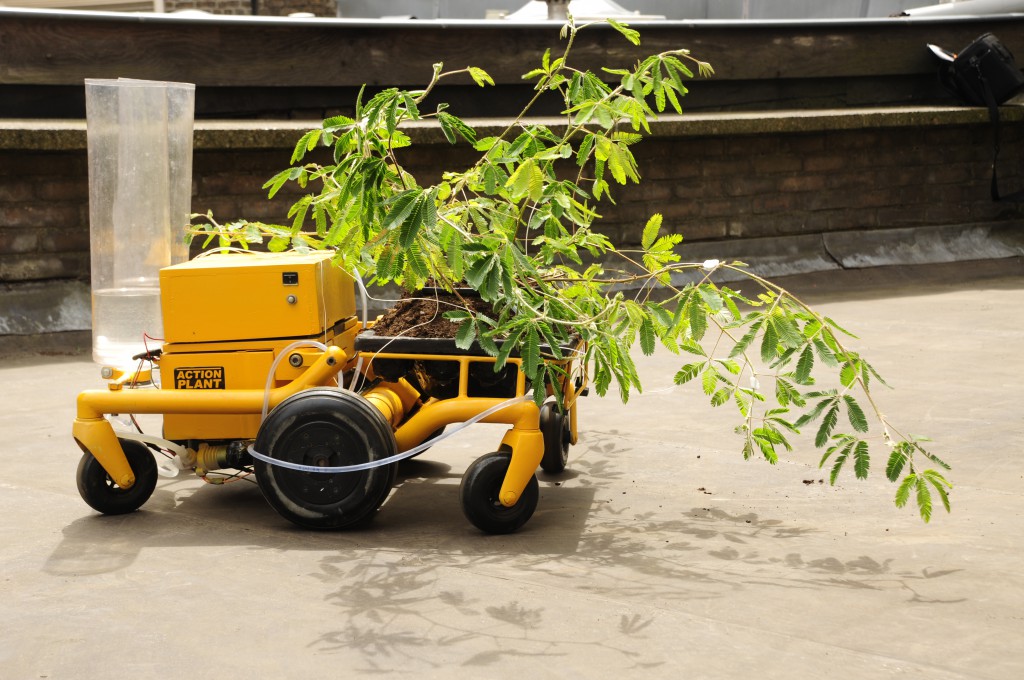
Jurema Action Plant aims to empower plants by enabling them to use similar technologies as humans use. It is also explores new ways of communication and co-relation between humans, living organism and a machine. Much like humans, animals and machines, the plants have an electrical signal traveling inside them, but they do not have nerves like humans and animals; nor wires and cables like machines. This electrical signal travels inside the cells of the plant. Inspired by this phenomenon, in collaboration with V2_, scientist Bert van Duijn from the Biology University and Hortus Botanicus, both from Leiden, on a research into electrical signals from this plant. A signal amplifier reads the differences around the plant to determine when it is being touched. These electromagnetic variations trigger movement of the robotic structure, on which the plant is situated, by means of a custom-made circuit board. The thresholds for response are set in such a way that only touching the plant makes the whole structure in motion.
Ivan Henriques
Ivan Henriques is a transdisciplinary artist and researcher working in multimedia installations examining living systems. He explores in his works hybrids of nature and (technological) culture creating new forms of communication between humans and other living organisms. He considers nature as inspiration and a necessary factor in the development of the technological world. His works is exhibited internationally, participating in festivals, residencies and talks. Recently he won the New Face Award from the 18th Japan Media Arts Festival and the Honorary Mention for the [next] Idea, Ars Electronica 2014.
http://www.ivanhenriques.com/
Bart Koppe A Small Stubborn Sound Machine
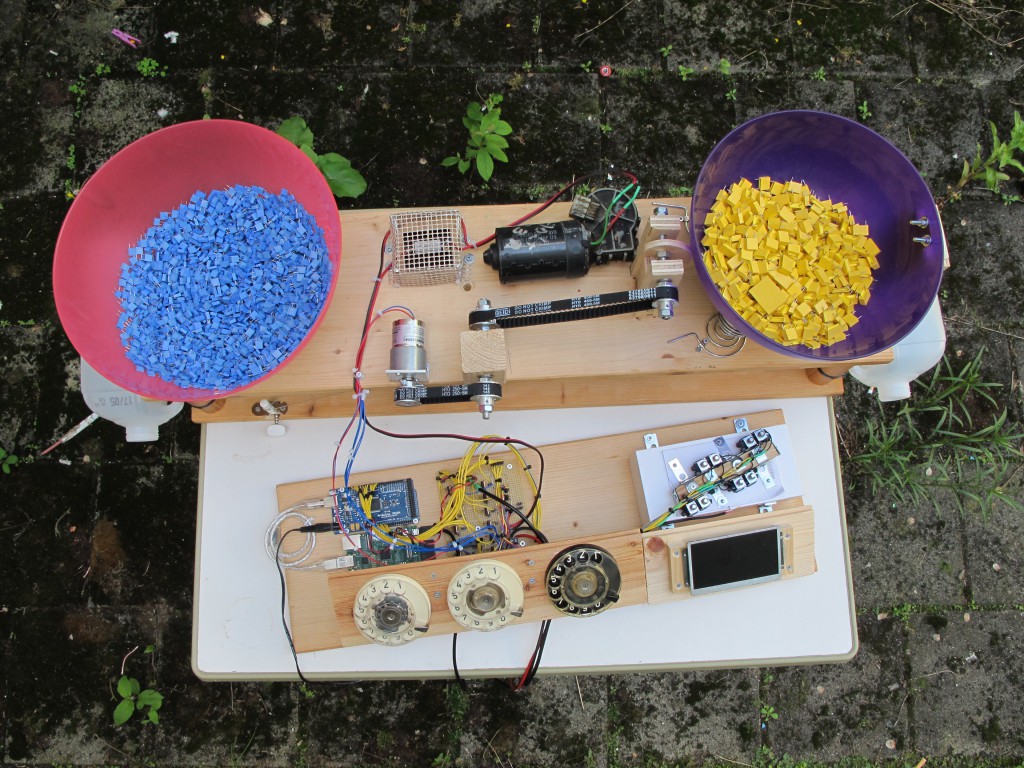
A Small Stubborn Sound Machine is a playful DIY sound instrument. Its mainly build from used objects. Like milk containers as sound boxes for guitar strings and a solenoid drum machine made of a cardboard phone package. The two salad bowls on top are each filled with a hand full of otherwise wasted electronic capacitors for both colour matching and creating some noise.
To make sound out of this there are three rotary telephone dials. With those you can control the speed, rhythm and capacity. After dialling a starting number for each element sound starts and can be changed continuously by playing with the dials.
Bart Koppe
Bart Koppe’s works usually consists of tangible interfaces in combination with electronics, computers, and networks. The concepts behind his installations and network art emerge from questions, experiences or thoughts about technological change and its influence on daily life. The communicational and social aspects of technology take an important place in most of his works.
http://a-bort.org
Jet Smits LC ENVIRONMENT
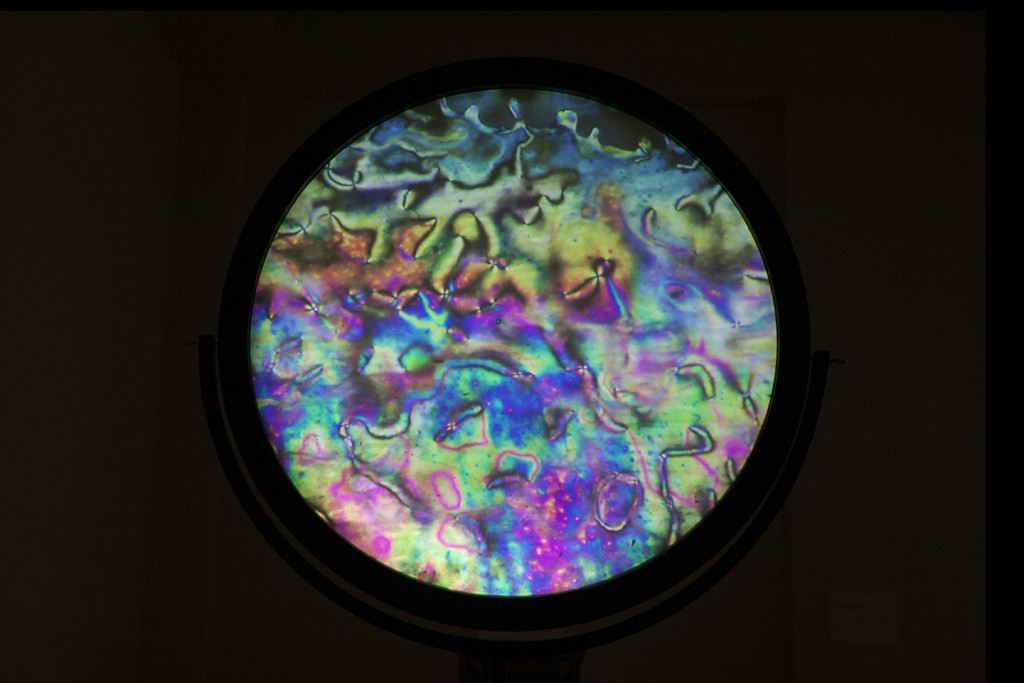
A little more then a century ago a new state of matter was discovered, a state between liquid and solid, with the remarkable propensity to self-organize into intricate lattices. Extremely sensitive to light, heat, electrical and magnetic stimulus, this breed of soft matter, known as liquid crystal, comprises all biological and cell membranes, soap solutions as well as most current display technologies. Inspired by the ephemeral dynamics of liquid crystallinity, artist Jet Smits collaborated with soft matter physicist Stephen Picken (TU Delft) to create the installation, LC Environment.
Jet Smits
New media artist Jet Smits explores the transitional border between the physical and the virtual world, investigating the transition point where data becomes sensorial, trying to capture that exact moment of change.
She finds herself in the area of science and technology related to our perception. Her phenomenological approach results in the use of different media and technologies to create immersive, contemplative installations, based on empirical research as well as thorough artistic and scientific experimentation.
www.jetsmits.nl
Marloes van Son COLC - undrown
COLC – undrown takes you through an underwater vortex. This natural phenomenon, which is normally created when rapidly rushing water passes an underwater obstacle, has been a long time subject of interest to both mythology and science. This installation searches for a fragile equilibrium between a natural phenomenon and technology. While trying to control a piece of nature it emphasizes on its unpredictability. Through the manipulation of a water vortex a natural phenomenon controls sound and light imaging. COLC – undrown floods a space with whirling water, refracting light and stirring sounds.
Marloes van Son
Marloes van Son builds systems in search of a fragile equilibrium between natural/scientific phenomena and technology. The electronic/mechanical systems that she builds, work together with a phenomenon in such a way that the result is a synergy of the two. Her installations try to control pieces of nature, while emphasizing on their unpredictability which make them (almost) uncontrollable.
While working as a ‘mad inventor’ she explores not just phenomena, but also experimental instruments, (interactive) installations and electronics. She gets inspiration from working with water, fire or air combined with light, movement and sound.
By creating experiences through manipulating natural/scientific phenomena, she hopes that people will learn to see the ‘real’ world as art. Her installations guide people through phenomena to (re)construct a fascination for their direct environment.
http://www.marloesvanson.nl/
Angela de Weijer Infinity Four: The Sublime Recorder
The Sublime Recorder is a speculative device designed to imprint new sonic energy into previously erased matter.
Within the discourse of infinite sound, matter is regarded as a medium. Matter has the ability to contain, absorb and emit sonic energy from past events. The Sublime Recorder is specifically intended to receive and direct sound towards the object inside, while protecting the object against sonic overload using a degree of isolation and filtering. You are invited to leave your own imprint.
Angela de Weijer
Angela de Weijer (Eindhoven, NL) is an audiovisual artist, educator and cultural producer in the field of art and technology.
She is an honours graduate of the Fontys School of Fine and Performing Art in Tilburg, and winner of the Jacques de Leeuw Young Talent award. De Weijer recently completed the masters’ programme at the ArtScience Interfaculty of the Royal Academy of Art and Royal Conservatoire in The Hague, where her graduation work received the Department Award.
Angela creates multidisciplinary experiences which operate on the border of the audible and inaudible, perceivable or imperceivable. Master research at ArtScience led her towards the elusive notion of infinite sound and (im)possibility thereof, resulting in a play between imagination and dogma.
http://www.missmilivolt.com/
Dick Raaijmakers' commentary on Pierre Boulez
Dick Raaijmakers has been a key figure in the development of electronic music. He has been questioning the electronic medium and its implications for contemporary music in terms of new possibilities and problems;
This lecture focuses on Raaijmakers’ music theatre piece DÉPONS / DER FALL in which he stages his commentary on Pierre Boulez’s approach to live electronic music in Répons. Dick Raaijmakers was the co-founder of the Interfaculty Image and Sound, now the Interfaculty ArtScience.
Michael van Hoogenhuyze
The way of ArtScience: a meeting of science and poetry
In this lecture Michael van Hoogenhuyze will argue that the art of today has been enabled by three key developments originating from Europe’s eighteenth century:
– The enlightenment and the process of using empirical sciences and logic to understand the world
– Art becoming a special discipline for creative thinking since romanticism
– The concept of time, especially history and evolution, as a way to describe the world and seeing this world as something to be changed continuously
A next step took place in the twentieth century when artists started to integrate technology and science in their work.
Two key developments are:
– Thinking with things, like it happened in Dadaism and Fluxus
– The invention of methods to handle technology in a poetical way, like it is described in the theories of Dick Raaijmakers.
Van Hoogenhuyze concludes that as a result most artworks are installations in an open form, using the initiatives of the public, confronting them with a poetical approach of technology.
This lecture is based on van Hoogenhuyze’s just published book, Van Muzisch Spel naar Muzisch Denken, (“From playing with the Muses to thinking with the Muses”)
Michael van Hoogenhuyze
Michael van Hoogenhuyze studied History of Art at Leiden University. Since his graduation in 1975 he has worked as an art historian and art history teacher, contributing to many curricula and working as school manager for many years. Next to his work as a teacher he is active in areas where art criticism and the reflection on art are transformed into actual contributions to the creative process. He participated in many projects of artists as a collaborator, researcher or dramaturge. In these projects he further developed his ideas about music, theatre and the geography of art. As part of his lectorate research at the KABK, he researched and wrote about his views on the creative process of the artist. As a result he published “Het Muzisch Denken”, “Thinking of the Muses” in 2007. Also he wrote many articles about artists and their work. Beside this field of interest he is a specialist in theories about space, the relation between visual art and music and the history and theory of teaching in the arts.

Notesaaz is both a new physical interface meant for musical performance and a proposal for a three stage process where the physical controller is used to navigate within a graphical score that on its turn controls the sound generation. By showing the dynamic score to the performer and the audience, Notesaaz shows new possibilities for staging the performer instrument relationship, inviting the audience to engage more in what is played and to anticipate on what happens next.
Erfan Abdi
Erfan Abdi takes advantage of the possibilities offered by technology with a DIY attitude, and constructs his instruments from found or re-purposed material, seeking new ways of relating to the world of production and consumption. He researches the concept of active perception in the context of performing arts, and the interactions between performer, instrument and audience. Looking for new ways to express the abstract, he creates spaces of simultaneous stimuli, and exposes the agential role as well as the phenomenal quality of the performer in intra-action with instrument and stage.
http://www.erfanabdi.com/
Mariska de Groot and Dieter Vandoren Shadow Puppet?
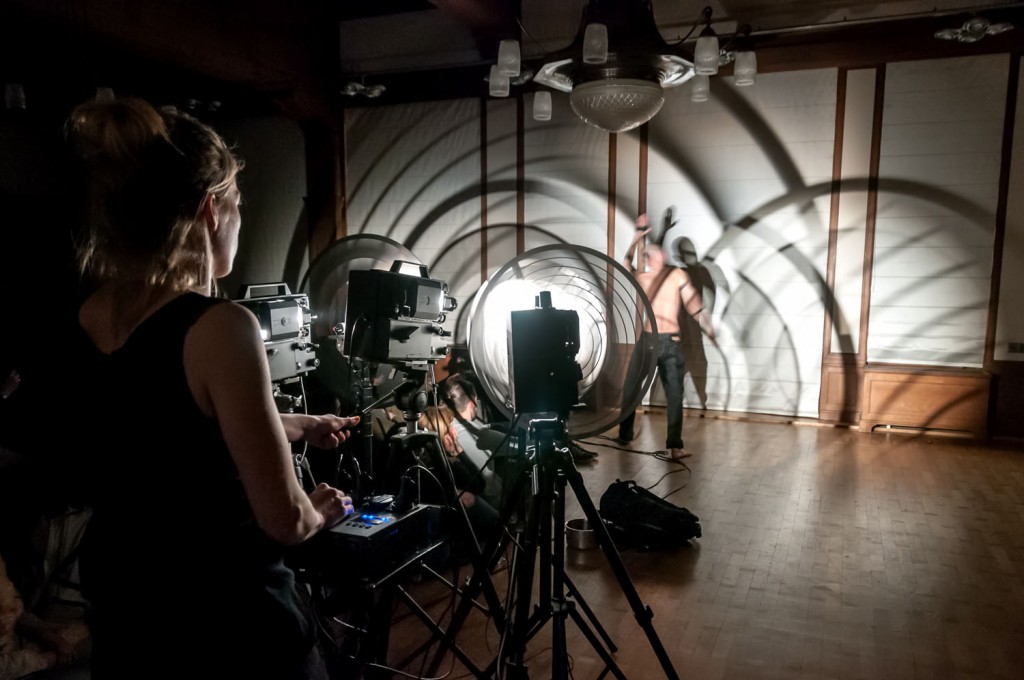
Shadow Puppet? presents an interplay of embodied performance and analog machinery that gives rise to an engulfing play of light, shadow and raw optical sound. Two performers – one behind the machines and one in the spotlights – play this light-to-sound instrument in a dynamic tension of attraction and repulsion. It never gets quite clear who is conducting who… In this project Dieter Vandoren and Mariska de Groot present a special collaboration wherein they integrate their respective expertises in embodied performance and optical sound.
Mariska shoots beams of light coded by graphical patterns engraved on motorized wheels. Dieter wears light sensors on his body, improvising a live optical-sound piece by catching fragments of the rotating light-shadow patterns through his movements. The music hidden within Mariska’s mesmerizing projections is revealed when touched by Dieter’s body.
Mariska de Groot
Intrigued by the phenomena and history of optical sound, Mariska de Groot [1982, NL] makes and performs comprehensive analog light-to-sound instruments and installations which explore this principle in new ways.
http://mariskadegroot.com
Dieter Vandoren
Dieter Vandoren is a media artist, performer and developer. His work balances on the edge of creative arts and scientific research & development. Drawing from his diverse backgrounds in music, informatics and interactive architecture, he is currently occupied with the development and performance of spatial, immersive audiovisual instruments with a strong focus on the embodied aspect of performance.
He is a guest tutor and researcher at the Hyperbody and ID-StudioLab groups at the Delft University of Technology (departments of architecture and industrial design, respectively), founding member of the iii collective and former director of cultural centre De Fabriek Rotterdam. He previously worked as developer and researcher at design office ONL[Oosterhuis_Lenard] and research group Hyperbody. He is part of the art direction team of Blikopener Festival & Producties.
http://www.dietervandoren.net/
The Leslies Soundtrack for an imaginary film, nr. 6 - Inferno a Paradiso

The Leslies, Horst Rickels and Robert Pravda, will perform with multiple speaker-objects obtained by repurposing the leslie speaker of the Hammond organ. After having been hidden in the cabinets of Hammond organs for decennia, now these leslie speakers find a new life. The relationship between the sound source, in this case the moving speaker as the sound object, and the space is explored as medium for creation of an immersive soundscape.
Horst Rickels
Horst Rickels, 1947, studied piano construction at Grotrian-Steinway in Braunschweig and worked in that function at Bechstein in Berlin. After this he studied music in Kassel where he composed ballet and theater music for the Staatstheater and was member of the underground-band ‘Pigblood’. In 1972 he started studying electronic composition at the Royal Conservatory in The Hague. From 1973 he worked as a composer for the theater group Proloog in Eindhoven. In 1983 he earned his degree in music theory at the Brabants Conservatorium with a thesis on the dialectics of Brecht’s texts and Eisler’s music. During the next years he formulated new principles for multi-media theater, resulting in, amongst others, Van Gogh’s Laatste Oor and The Simulated Wood. Supported by a grant from the Fonds voor Scheppende Toonkunst he focused his research on the development of sound objects, sound sculptures and sound installations.
The central question of his research is how the principle of instability of tuning-systems, pictorial structures and performance practices can be made the central theme of art works. Another important aspect of his research is the study of spatial qualities of sound in relation to the natural and artificial environment. As a sound artist he has shown his works in many countries and at international festivals. Often he has participated in projects that aimed at transforming outstanding places into a soundscape, such as Fort Klank in 1994 in which he, Dick Raaijmakers, and Walter Maioli transformed an old fortification into a monumental musical instrument.
From 1985 until 2006 Rickels worked as a lecturer at the Design Academy Eindhoven where he initiated sound-, theatrical- and interdisciplinary projects. In 1989 Rickels was invited to teach at the Interfaculty ArtScience of the Royal Conservatoire and the Royal Academy in The Hague. From 2002 till 2008 he has been coordinating the ArtScience masters program and he has been the acting head of the Interfaculty in 2007 and 2008. He composed the soundtracks for diverse films of his daughter Jiska Rickels, among which ‘Himmelfilm’, ‘Untertage’ and ’4Elements’ which won different international prizes. In 2006/07 Horst Rickels was artist in residence at the NFTA (Dutch Film and Television Academy) with a research on the dialectics on music/sound and moving pictures.
Robert Pravda
Robert Pravda (26-12-1967) is a sound-artist, composer and performer currently living in Rotterdam in the Netherlands. He studied interdisciplinary art at the Royal Academy for Fine Arts Music and Dance in the Hague at Interfaculty Sound and Image department. Pravda is building installations, composing for theatre, and performing live electro-mechanical music.
From 2002 ‘till present, he is teaching introduction courses, developing research projects and coaching an improvisation ensemble RecPlay and Performative Installations Lab as a member of the teaching team of the ArtScience department on the Royal Academy of Art and Royal Conservatory. Since 2009 he is an active member of Tilt. Tilt is an interdisciplinary platform founded by choreographer Andrea Bozic, sound artist Robert Pravda and visual artist Julia Willms to inspire and support artistic practice and thinking beyond disciplines.
He is active in exhibiting his work and performing in the Netherlands and abroad.
Matthijs Munnik and Joris Strijbos U-AV Live
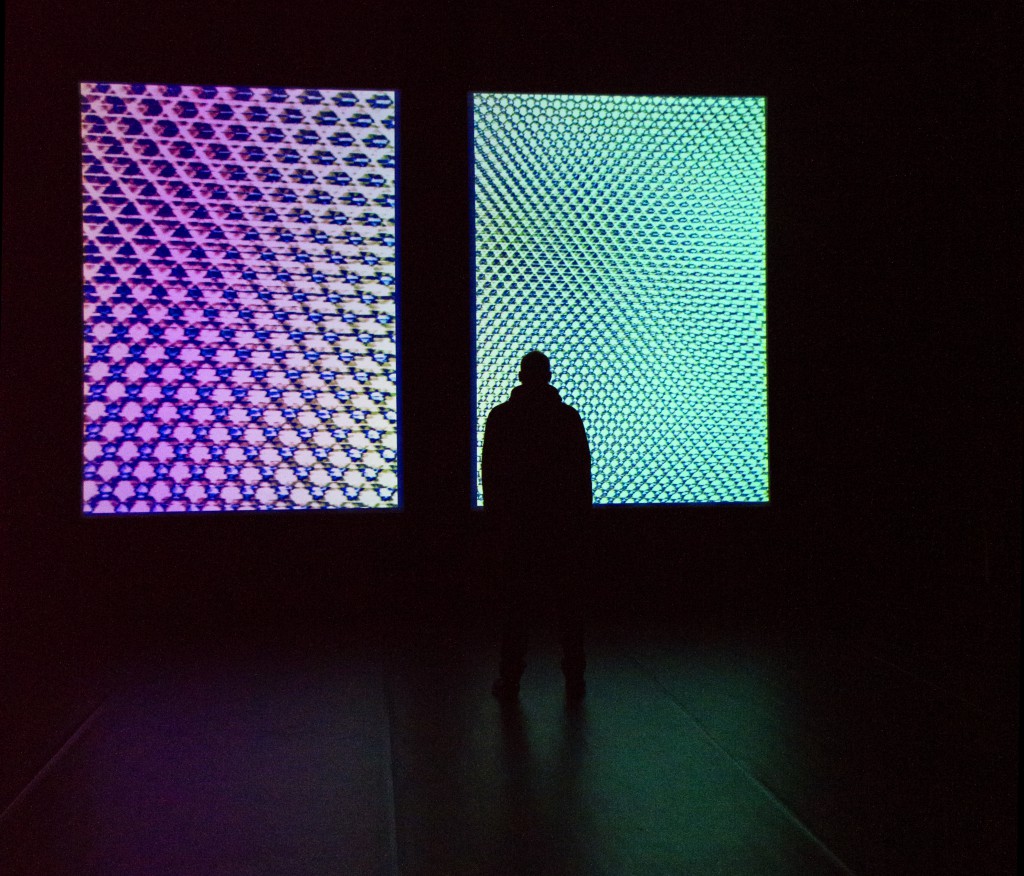
In “U-AV” Joris Strijbos and Matthijs Munnik build synaesthetic landscapes from electronic sound structures, generative video and stroboscopic light. The project is the result of a combined research on the side effects of human perception and how the eyes perceive visual complexity in combination with external flicker images and loud pulsating sounds.
While the performance relentlessly over-stimulate the audiovisual senses, the work opens up and envelops the audience in a meditative and hypnotic zone where the spectator can dream away in the abstract worlds that pass.
Concept and production: Joris Strijbos and Matthijs Munnik
“U-AV” was realized with the support of Sonic Acts Festival and was selected for SHAPE, Sound, Art and Performance Heterogenous Europe and The Creative Europe program of the European Commission.
Matthijs Munnik
Munnik studied at the Royal Academy of Arts in The Hague. He has exhibited at museums and festivals internationally, among others Sonic Acts (NL), Ars Electronica (AU) and TodaysArt (NL, RU, JP). Munnik won the Artist & Designers 4 Genomics award for his Microscopic Opera project. He is currently a resident at the Rijksakademie in Amsterdam.
http://www.matthijsmunnik.nl/
Joris Strijbos
Joris Strijbos is a Rotterdam-based artist whose work focuses on the synaesthetic relation and interaction between moving image and sound. His work consists of a series of kinetic audiovisual installations and new media performances inspired by an ongoing research into cybernetics, emergent systems, artificial life and communication networks within groups. In his installations he combines artificial, electronic and digital media with models and algorithms based on biological systems. His work has been widely shown at festivals, galleries and museums like Ars Electronica – Linz, Sonic Acts Festival – Amsterdam, DEAF Biennale – Rotterdam, Woodstreet Galleries – Pittsburgh, WRO International Media Art Biennale – Wroclaw, Van Gogh Museum – Amsterdam.
http://jorisstrijbos.nl
Optical Machines SHIFT
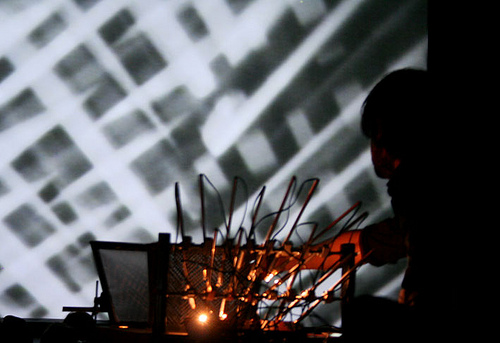
Optical Machines
Optical Machines make a pure, authentic impression by combining their creations of sounds and visuals. Rather than taking a static position they choose an open set-up which invites the audience to their laboratory-like playground. Their set-up contains an obscure variety of modified equipment, pattern models, lamps, lenses, cameras and analogue synthesizers to make a both hypnotic and fascinating performance. Optical Machines make a real live show with visuals and sound created on the spot!
For their performance (SHIFT), this approach has been retained. The way in which the two men work can also easily be followed and is a significant part of the performance, while the equipment is again manufactured by them. A kind of Pandora’s Box, an ingenious case with a battery of lights, forms the basis of a play with interfering patterns and abstract animation. (SHIFT) is a real live show with light images that are generated, manipulated, mixed and projected on the spot. The interaction between image and sound is twofold: the soundtrack influences the image and vice versa.
The work of Optical Machines has been performed at various festivals around the world including; Sonic Acts (Amsterdam), CTM (Berlin), Skiff (St Petersburg), Rojo Nova (Brazil), Rokolectiv (Bucharest), Festival Du Nouveau Cinema (Montreal) and Kontaste (Austria)
http://www.opticalmachines.nl/
Rikkert Brok
Is fascinated by light and projections. By experimenting with lamps, lenses etc. Rikkert has developed an unique view on moving images. The equipment is often as important as the projected images. Therefore Rikkert chooses for an open construction so the spectator can view the origin of the images. Rikkert studied at the Interfaculty Image and Sound in Den Haag and graduated in 2002.
Maarten Halmans
Started in the early 90’s with electronic music and developed a great interest in analogue synthesizers. To be able to design his own analogue synthesizers and interfaces he went to college to get a degree in electronic engineering in 2001. In 2004 he started a company for repair, modification and custom build electronic musical instruments, www.artefacts.nl
Joost Rekveld #37

Andronicos says that in a certain place in Spain one finds small, scattered stones which are polygonal and grow spontaneously.
Some of them are white, others are like wax and pregnant of smaller stones similar to themselves.
I kept one to verify this myself and it gave birth at my place, so the story is not a lie.
(Paradoxographus Palatinus, anonymous, 3rd century)
Joost Rekveld
Joost Rekveld is an artist who is motivated by the question of what we can learn from a dialogue with machines. In his work, he explores the sensory consequences of systems of his own design, often inspired by forgotten corners in the history of science and technology. These systems combine temporary dogma’s in the form of procedures or code, with more open-ended elements such as material processes or networks of interactions that are too complex to predict. His films, installations and performances are composed documentaries of the worlds opened by such systems. In their sensuality they are an attempt to reach an intimate and embodied understanding of our technological world.
His films have been shown world-wide in a wide range of festivals and venues for experimental film, animation or other kinds of moving image. He realized several installations and did many collaborative projects involving composers, music ensembles, theatre companies and dance companies. Since 1990 he has been putting together many film programmes, he curated several exhibitions and he occasionally publishes essays. He has been giving lectures since 1993, has been teaching since 1996, and from 2008 to 2014 he was the course director of the ArtScience Interfaculty of the Royal Conservatoire and the Royal Academy of Art in The Hague.
http://www.joostrekveld.net/
Telcosystems Loudthings
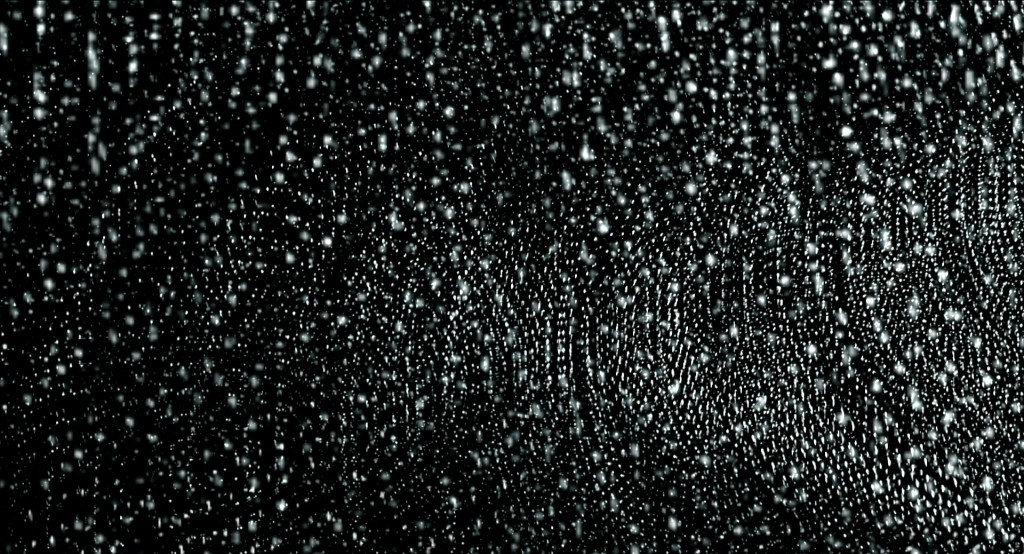
Loudthings is an audiovisual account of an expedition into the inside world of the computer. Using a set of elementary instructions such as modulation, masking, and feedback, Telcosystems programmed a self-organizing network of algorithmic processes for the creation of spatial image and sound. The result is a non-referential world which strains the senses; an exploration along the borders of human perception, through worlds of multiplying and mushrooming clouds of light and sound, through worlds of mesmerizing spatiality and interfering landscapes.
Loudthings has been nominated for a Tiger Awards for Short Film at IFFR 2008 and won the Gus Van Sant Award for Best Experimental Film at the Ann Arbor Film Festival 2009 and the Grand Prix 2008 at 25 FPS festival in Zagreb Croatia.
Loudthings premiered at the IFFR film festival Rotterdam in 2008, and has been shown since at festivals such as Ann Arbor film festival, EX-IS Seoul, EMAF Osnabruck, IKFF Hamburg, VideEx Zurch, 25FPS Zagreb, NFF Utrecht, ISFF Lille, Spectropia Riga.
Loudthings was made possible by the generous support from: Netherlands Foundation for Visual Arts, Design and Architecture, The Netherlands Film Fund, The Rotterdam Film Fund, ThuisKopie Fonds.
Telcosystems
Gideon Kiers, David Kiers and Lucas van der Velden are the founding members of Telcosystems. Lucas van der Velden (1976, Eindhoven) and Gideon Kiers (1975, Amsterdam) studied at the Interfaculty Image and Sound, a department of the Royal Conservatoire and the Royal Academy of Art in The Hague. David Kiers (1977, Amsterdam) studied at the Sonology department of the Royal Conservatoire.
In their audiovisual works Telcosystems research the relation between the behavior of programmed numerical logic and the human perception of this behavior; they aim at an integration of human expression and programmed machine behavior. This becomes manifest in the immersive audiovisual installations they make, in films, videos, soundtracks, prints and in live performances. The software they write enables them to compose ever-evolving audiovisual worlds. Telcosystems’ installations and films focus on real-time, self-structuring, generative processes, in their live performances they focus on the interaction with these processes. Their work is the result of an ongoing search for an own language of non-referential image and sound, and is characterized by lucid and restrained aesthetics, closely related to the technology they use. In interaction with machines Telcosystems fuse the auditive and visual domains into one immersive spatial experience that explores the limits of the human sensory apparatus.
http://www.telcosystems.net/
Mika Vainio
Mika Vainio, currently based in Berlin, was one half of the minimal electronic duo Pan Sonic from Finland, (the other half was Ilpo Väisänen). Before starting Pan Sonic in the beginning of the 90’s, Mika Vainio has played electronics and drums as part of the early Finnish industrial and noise scene.
His solo works, under his own name and under aliases like Ø, are known for their analogue warmth and electronic harshness. Be it abstract drone works or minimal avant techno, Vainio is always creating unique, physical sounds.
He has released on labels like editions Mego, Touch, Wavetrap and Sähkö and he has been producing among others with Alan Vega of Suicide, Keiji Haino, Chicks on Speed, John Duncan and Bruce Gilbert. Mika Vainio’s performance is the only part of the programme that is not directly related to the ArtScience Interfaculty. His performance will close off the evening.
http://www.mikavainio.com


